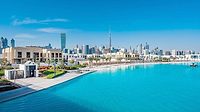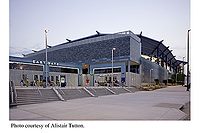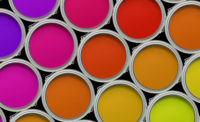Performance Expectations for UV-Durable Coil Coatings


















In today’s competitive environment, many companies claim that SMP and super-polyester coatings equal or exceed the performance capabilities of 70% PVDF coatings. This article examines the differences between 70% PVDF coatings, SMP and super-polyester coatings, and evaluates the true long-term performance of each coating technology.
The Basics
Coil coatings are made from three basic ingredients: resins, pigments and solvents.
Resins
Resins give coil coatings basic performance characteristics such as resistance to abrasion, scratching, moisture and ultraviolet (UV) light, as well as mechanical characteristics such as adhesion, hardness and flexibility during fabrication.
Coil coatings are formulated with several resin types, including acrylic, epoxy, polyester and PVDF polymers. For applications that demand a highly durable coating surface, such as metal roofing, composite panels, building panels and curtain walls, 70% PVDF coatings are regarded as superior due to their strong UV resistance. Because of their lower cost and harder finishes, SMP and super-polyester coatings are traditionally favored for applications such as warehouses, industrial, storage and agricultural structures and other non-monumental commercial buildings.
In recent years, some manufacturers have sought to position SMP and super-polyester coatings as viable, low-cost alternatives to 70% PVDF coatings. While it is true that polyester coatings are more resistant to UV damage than early-generation coatings, they do not offer the same weatherability, color retention and gloss retention as 70% PVDF coatings.
To understand why, it helps to know the chemical structure of various resins. PVDF resin molecules are composed of alternating carbon-fluorine and carbon-hydrogen bonds. Carbon- fluorine bonds are among the strongest in the chemical world. Consequently, they render PVDF resins chemically and photo-chemically inert, and, therefore, virtually immune to degradation from sunlight, moisture, acids, pollutants and chemicals. That is the reason for their superior durability.
By contrast, molecules in SMP and super-polyester resins are based on carbon-hydrogen, carbon-oxygen and carbon-silicone bonds. Because their molecular bonds are weaker, long-term exposure to UV light and environmental hazards eventually defeats the structural chemical integrity of the polyester coating, causing it to chalk or fade.
Pigments
Pigments are colorants made from fine powders. There are three types of pigments – organic, inorganic and ceramic – and their chemical structure determines their stability (ability to resist fading). Because ceramic pigments are made from metal oxides fused under high temperatures, they are the most chemically stable and fade-resistant. Consequently, they are the default choice for coatings systems warranted to satisfy the most demanding performance expectations, such as high-end architectural applications.
Solvents
Solvents are carriers that make coatings easy to apply. They do so by solvating resin to a desired consistency and dispersing pigments evenly throughout the coating. Solvents have no effect on coating performance.
Ultimately, a coating is only as good as the sum of its parts. If a coating is formulated from strong, durable resins but weak pigments, it has the potential to chalk or fade prematurely. Conversely, durable resins combined with strong pigment systems will deliver long-lasting performance.
In short, a coatings formulation cannot be strong if any of its individual components are weak. High-quality raw materials are essential to the long-term durability and performance of any coating.
Be Wary of Performance Claims
In recent years, some manufacturers have sought to imply that SMP and super-polyester coatings can offer the same long-term performance benefits as 70% PVDF coatings.
This practice is misleading for two reasons. First, as demonstrated in the previous section, SMP and super-polyester coatings do not have the chemical structure needed to sustain the long-term performance of 70% PVDF coatings.
Second, and perhaps even more critically, SMP and super-polyester coatings do not have long-term weather exposure data equal to 70% PVDF coatings, which have a 45-year history of proven durability on buildings throughout the world.
Since 70% PVDF coil coatings debuted in the 1960s, they have been continuously subject to South Florida exposure testing. In this testing, coatings are applied to metal panels and exposed at a 45°angle to South Florida’s notoriously harsh humidity and UV light, then measured at five-year intervals for chalk, fadeand other signs of environmental degradation.
New SMP and super-polyester coatings are introduced every four to five years. Consequently, these products have no more than 10 to 15 years of performance data in South Florida exposure testing or actual building performance. Despite the lack of requisite testing, many of these coatings are warranted at terms comparable to 70% PVDF coatings.
Some coatings manufacturers seek to dismiss this concern by insisting that performance data for new SMP and super-polyester coatings supersedes that of older products. New polyester technologies may, in fact, be superior to the earlier polyester formulations, but they cannot achieve the long-term performance of 70% PVDF coatings because, ultimately, the molecular structure of the base polyester resins will cause them to fail.
Coatings specifiers also should examine if and how their warranty distinguishes between vertical and non-vertical surfaces. Many warranties cover vertical and non-vertical surfaces differently because non-vertical surfaces such as roofing are much more susceptible to failure than vertical exposures. Seventy-percent PVDF coatings purchased from proven, reputable coil coatings manufacturers will provide equal chalk and fadecoverage for vertical and non-vertical surfaces.
Chalk and Fade
As explained in “The Basics,” chalk or faderesult directly from the chemical breakdown of a coating’s base resins and pigments, which ultimately appear as a visible loss of color and/or gloss.
Chalk is the appearance of a powdery substance on the surface of a coating. In accordance with ASTM D4214-98 test procedures, it is measured by rubbing the coated surface with a soft fabric and calculating the amount of powder that is picked up on a scale from 1 (extremely poor) to 10 (perfect), as depicted in Figures 1-3.
Fade is the loss of color calculated in Hunter ΔE units in accordance with ASTM D2244-02 procedures. One ΔE unit denotes the smallest degree of color change visible to the naked eye (Figure 4).
While it may not appear so on paper, a difference of one or two points in a chalkrating, or of more than five ΔE Hunter units in a fademeasurement, can mean the difference between a coating that maintains its original appearance for 30, 40 or 50 years from one that looks old much sooner.
PVDF vs. Polyester
After 40 years of UV exposure, PVDF coatings and polyester coatings will react differently in exterior environments. As Figure 5 indicates, in the initial five years of exposure, both types of coatings will have a slight shift in color fade and chalkvalues; yet, over time, the differences in their composition will become clearer.
While PVDF-quality coatings will have a very gradual decline in color fade and chalkover a 40-year period, polyester coatings will match PVDF coatings for a time then abruptly lose performance. On average, durable polyesters may have half the life expectancy of PVDF coatings, which severely limits their long-term performance.
The Benefits of Adding a Clear Coat
PVDF coatings are available as two- or three-coat systems, with the third coat representing the application of a clear topcoat. In most circumstances, the clear coat is applied to protect the metallic flake from tarnishing and changing color during UV exposure.
Another benefit of clear coats that is often overlooked is that they minimize accumulation of dirt and make metal building surfaces easier to clean. This is critical in severe industrial environments or coastal areas where buildings can be exposed to chemical fallout or salt spray. Industrial environments can aggressively attack the color stability of coatings. Fallout from industrial complexes, in particular, can fade color dramatically within a short period of time. One way to extend color life in harsher environments is to apply a clear coat over the color coat to protect the pigmentation from fade. The two metal panels pictured in Figure 6 demonstrate the differences in fade after five years. The left side of each panel has been treated with a clear topcoat as part of a three-coat system, while the right side of each panel has been left unprotected with a conventional two-coat system and no clear coat. Industrial fallout has attacked and completely removed the aluminum flake from the unprotected (right) side of each panel, causing them to appear as solid, non-metallic colors.
Resistance to UV exposure also is enhanced with a clear coat, as demonstrated by the two photos below, allowing manufacturers to provide improved warranties for chalk and fade. The four metal panels in Figures 7 demonstrate the long-term performance of PVDF coatings treated with a three-coat system with a clear coat. After 20 years of South Florida exposure testing, they have lost virtually no color or gloss, unlike the panels in Figure 8, which were not treated with a clear coat.
Comparing the Coatings
Table 1 illustrates the relative strengths of four commonly specified types of architectural coatings.
Summary and Conclusions
- Coil coatings are formulated from three main ingredients: resins, pigments and solvents.
- Coil coatings formulated with polyester resins, including the latest SMP and super-polyester resins, do not offer the same long-term performance as 70% PVDF coatings. This is due to the superior molecular strength of 70% PVDF resins.
- Warranties for coil coatings are not a reliable indicator of coatings performance.
- When comparing warranties for SMP, super-polyester and 70% PVDF coil coatings, scrutinize their length and terms, particularly for performance factors such as chalk and fade.
- Coatings manufacturers should have South Florida exposure data that covers a reasonable amount of time. Be wary of test data that does not extend beyond five to 10 years because it does not effectively represent the long-term performance expectations associated with most high-end commercial and residential architectural applications.
The excellent performance of 70% PVDF coatings for architectural application has led many architects to regard them as commodity products. PPG has manufactured Duranar® 70% PVDF coatings for more than 45 years and is the only remaining original licensee of Kynar 500®, the first-generation PVDF resin that serves as a base ingredient for Duranar coatings.
The reasons for PPG’s superior performance are three-fold: 1. Although 70 percent of the Duranar resin system is formulated with Kynar 500 or Hylar® 5000 PVDF resins, the remaining 30 percent is made with proprietary PPG resins. 2. Duranar coatings are made with proprietary PPG pigments that have been tested on thousands of exposure sites. In fact, no color pigment is added to the Duranar coatings palette until it has been exposure-tested under harsh conditions for at least 10 years. 3. Duranar coatings incorporate high-quality solvents formulated exclusively by and for PPG coatings. As a result of these proprietary ingredients, PPG coatings have durability and colorfastness.
For more information, call 1-888-PPG-IDEA (774-4332) or visit www.ppgideascapes.com.
Looking for a reprint of this article?
From high-res PDFs to custom plaques, order your copy today!


















